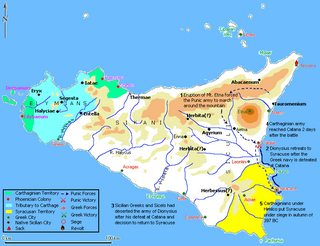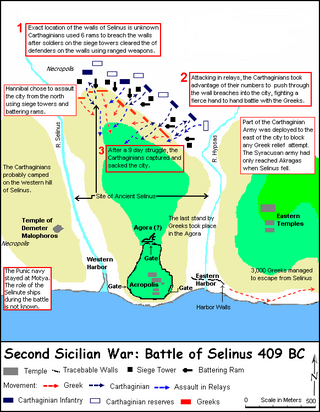
The Battle of the Crimissus was fought in 339 BC between a large Carthaginian army commanded by Asdrubal and Hamilcar and an army from Syracuse led by Timoleon. Timoleon attacked the Carthaginian army by surprise near the Crimissus river in western Sicily and won a great victory. When he defeated another much smaller force of Carthaginians shortly afterwards, Carthage sued for peace. The peace allowed the Greek cities on Sicily to recover and began a period of stability. However, another war between Syracuse and Carthage erupted after Timoleon's death, not long after Agathocles seized power in 317 BC.

The Battle of the Himera River was fought in 311 BC between Carthage and Syracuse near the mouth of the Himera river. Hamilcar, grandson of Hanno the Great, led the Carthaginians, while the Syracusans were led by Agathocles. Agathocles initially surprised the Carthaginians with an attack on their camp, but the Greeks lost the battle when they were attacked by unexpected Carthaginian reinforcements. The Greek army took many casualties as it retreated. Agathocles managed to gather the remains of his army and retreat to Syracuse, but lost control of Sicily.

The siege of Syracuse in 397 BC was the first of four unsuccessful sieges Carthaginian forces would undertake against Syracuse from 397 to 278 BC. In retaliation for the siege of Motya by Dionysius of Syracuse, Himilco of the Magonid family of Carthage led a substantial force to Sicily. After retaking Motya and founding Lilybaeum, Himilco sacked Messana, then laid siege to Syracuse in the autumn of 397 BC after the Greek navy was crushed at Catana.

The Battle of Selinus, which took place early in 409 BC, is the opening battle of the so-called Second Sicilian War. The ten-day-long siege and battle was fought in Sicily between the Carthaginian forces under Hannibal Mago and the Dorian Greeks of Selinus. The city of Selinus had defeated the Elymian city of Segesta in 415, an event that led to the Athenian invasion of Sicily in 415 and ended in the defeat of Athenian forces in 413. When Selinus again worsted Segesta in 411, Carthage, responding to the appeal of Segesta, had besieged and sacked Selinus after the Carthaginian offer of negotiations had been refused by the Greeks. This was the first step towards Hannibal's campaign to avenge the Carthaginian defeat at the first battle of Himera in 480. The city of Selinus was later rebuilt, but never regained her former status.

Near the site of the first battle and great Carthaginian defeat of 480 BC, the Second Battle of Himera was fought near the city of Himera in Sicily in 409 between the Carthaginian forces under Hannibal Mago and the Ionian Greeks of Himera aided by an army and a fleet from Syracuse. Hannibal, acting under the instructions of the Carthaginian senate, had previously sacked and destroyed the city of Selinus after the Battle of Selinus in 409. Hannibal then destroyed Himera which was never rebuilt.

The siege of Akragas took place in 406 BCE in Sicily; the Carthaginian enterprise ultimately lasted a total of eight months. The Carthaginian army under Hannibal Mago besieged the Dorian Greek city of Akragas in retaliation for the Greek raids on Punic colonies in Sicily. The city managed to repel Carthaginian attacks until a relief army from Syracuse defeated part of the besieging Carthaginian army and lifted the siege of the city.

The Battle of Gela took place in the summer of 405 BC in Sicily. The Carthaginian army under Himilco, which had spent the winter and spring in the captured city of Akragas, marched to confront the Greeks at Gela. The Syracuse government had deposed Daphnaeus, the unsuccessful general of the Greek army at Akragas, with Dionysius, another officer who had been a follower of Hermocrates. Dionysius schemed and gained full dictatorial powers.
The Battle of Messene took place in 397 BC in Sicily. Carthage, in retaliation for the attack on Motya by Dionysius, had sent an army under Himilco, to Sicily to regain lost territory. Himilco sailed to Panormus, and from there again sailed and marched along the northern coast of Sicily to Cape Pelorum, 12 miles (19 km) north of Messene. While the Messenian army marched out to offer battle, Himilco sent 200 ships filled with soldiers to the city itself, which was stormed and the citizens were forced to disperse to forts in the countryside. Himilco later sacked and leveled the city, which was again rebuilt after the war.

The Battle of Catana took place in the summer of 397 BC. The Greek fleet under Leptines, the brother of Dionysius I of Syracuse, engaged the Carthaginian fleet under Mago near the city of Catana in Sicily. While the Greek army under Dionysius was present near the city of Catana during the battle, the Carthaginian army under Himilco was away in the interior of Sicily, making a detour around the erupting Mount Etna. The Carthaginian fleet crushed the Greek fleet in the battle, leading to the Carthaginian siege of Syracuse later in 397 BC.
The Magonids were a political dynasty of Ancient Carthage from 550 BCE to 340 BCE. The dynasty was first established under Mago I, under whom Carthage became pre-eminent among the Phoenician colonies in the western Mediterranean. Under the Magonids, the Carthaginian Empire expanded to include Sardinia, Libya, and for almost a decade much of Sicily.
The Battle of Abacaenum took place between the Carthaginian forces under Mago and the Siceliot army under Dionysius in 393 BC near the Sicilian town on Abacaenum in north-eastern Sicily. Dionysius, tyrant of Syracuse, had been expanding his influence over Sicels' territories in Sicily. After Dionysius' unsuccessful siege in 394 BC of Tauromenium, a Carthaginian ally, Mago decided to attack Messana. However, the Carthaginian army was defeated by the Greeks near the town of Abacaenum and had to retire to the Carthaginian territories in Western Sicily. Dionysius did not attack the Carthaginians but continued to expand his influence in eastern Sicily.
The Battle of Chrysas was a battle fought in 392 BC in the course of the Sicilian Wars, between the Carthaginian army under Mago and a Greek army under Dionysius I, tyrant of Syracuse, who was aided by Agyris, tyrant of the Sicel city of Agyrium. Mago had been defeated by Dionysius at Abacaenum in 393, which had not damaged the Carthaginian position in Sicily. Reinforced by Carthage in 392, Mago moved to attack the Sicles allied with Syracuse in central Sicily. After the Carthaginians reached and encamped near the river Chrysas, the Sicels harassed the Carthaginian supply lines causing a supply shortage, while the Greek soldiers rebelled and deserted Dionysius when he refused to fight a pitched battle. Both Mago and Dionysius agreed to a peace treaty, which allowed the Carthaginians to formally occupy the area west of the River Halycus, while Dionysius was given lordship over the Sicel lands. The peace would last until 383, when Dionysius attacked the Carthaginians again.
The siege of Tauromenium was laid down by Dionysius, tyrant of Syracuse, in the winter of 394 BC, in the course of the Sicilian Wars against Carthage. After defeating the Carthaginians at the Battle of Syracuse in 397 BC, Dionysius had been expanding his territory and political influence by conquering Sicel lands and planting Greek colonies in northeastern Sicily. Tauromenium was a Sicel city allied to Carthage and in a position to threaten both Syracuse and Messina. Dionysius laid siege to the city in the winter of 394 BC, but had to lift the siege after his night assault was defeated. Carthage responded to this attack on their allies by renewing the war, which was ended by a peace treaty in 392 BC that granted Dionysius overlordship of the Sicels, while Carthage retained all territory west of the Halykos and Himera rivers in Sicily.
Mago II, also known as Magon, was Shofet of Carthage from 396 to 375 BCE, and was a member of the Magonid dynasty. He became Shofet after the suicide of Himilco II in 396 BCE and was succeeded by Mago III in 375 BCE.
Himilco was a member of the Magonids, a Carthaginian family of hereditary generals, and had command over the Carthaginian forces between 406 BC and 397 BC. He is chiefly known for his war in Sicily against Dionysius I of Syracuse.
The siege and subsequent sacking of Camarina transpired in 405 BC, during the Sicilian Wars.
The siege of Syracuse by the Carthaginians from 311 to 309 BC followed shortly after the Battle of the Himera River in the same year. In that battle the Carthaginians, under the leadership of Hamilcar the son of Gisco, had defeated the tyrant of Syracuse, Agathocles. Agathocles had to retreat to Syracuse and lost control over the other Greek cities on Sicily, who went over to the Carthaginian side.

The Battle of White Tunis was fought between Carthage and the tyrant Agathocles of Syracuse in 310 BC. It was the first large battle of the Agathocles' military expedition to Libya. Even though heavily outnumbered by the Carthaginian army, the soldiers of Agathocles were far more experienced in warfare than the Carthaginian citizen soldiers. Another important factor was the terrain, which prevented the Carthaginians from using their numbers to outflank Agathocles. The Carthaginian suffered a serious defeat, which caused some of the Carthaginian allies to change their allegiance to Agathocles.

The siege of Syracuse from 344 to 343/342 BC was part of a war between the Syracusan general Hicetas and the tyrant of Syracuse, Dionysius II. The conflict became more complex when Carthage and Corinth became involved. The Carthaginians had made an alliance with Hicetas to expand their power in Sicily. Somewhat later, the Corinthian general Timoleon arrived in Sicily to restore democracy to Syracuse. With the assistance of several other Sicilian Greek cities, Timoleon emerged victorious and reinstated a democratic regime in Syracuse. The siege is described by the ancient historians Diodorus Siculus and Plutarch, but there are important differences in their accounts.
The Battle of Cronium was part of the Sicilian Wars and took place in Sicily. A Syracusan army, led by Dionysius I, was defeated by a Carthaginian army, led by Himilco Mago, Mago II's son. The Carthaginians won the day having routed the enemy army. Leptines, Dionysius' brother, was killed during the battle. The location of Cronium is considered to be close to modern Palermo.